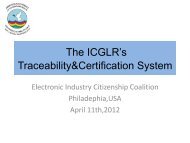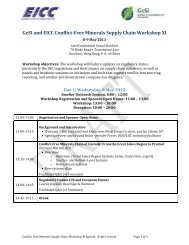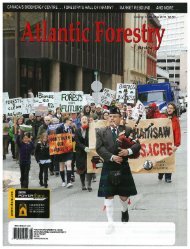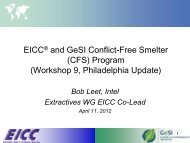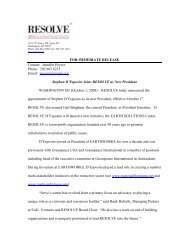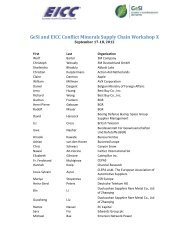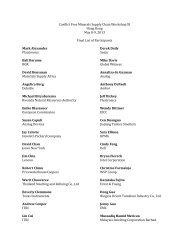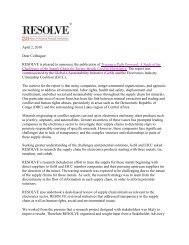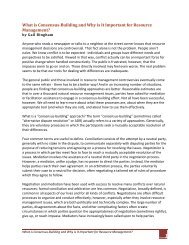Toward SuSTainabiliTy: The roleS and limiTaTionS of ... - Resolve
Toward SuSTainabiliTy: The roleS and limiTaTionS of ... - Resolve
Toward SuSTainabiliTy: The roleS and limiTaTionS of ... - Resolve
You also want an ePaper? Increase the reach of your titles
YUMPU automatically turns print PDFs into web optimized ePapers that Google loves.
Chapter 2: Actors – NGOs <strong>and</strong> Civil Society 22More recently, NGOs have played a leading rolein setting st<strong>and</strong>ards through multi-stakeholderroundtables. Since 2004, for example, the WWFhas hosted the Aquaculture Dialogues. More than2,000 people—including producers, NGOs, academics,<strong>and</strong> others—have participated in thesediscussions to date, which seek to identify theprimary environmental impacts associated withaquaculture <strong>and</strong> agree upon st<strong>and</strong>ards to minimizethese impacts. Of the eight dialogues started(for farmed shrimp, salmon, tilapia, bivalves, abalone,pangasius, trout, <strong>and</strong> cobia <strong>and</strong> seriola), fourhave been completed, with st<strong>and</strong>ards approved bythe multi-stakeholder steering committees. 4 Tomaintain the st<strong>and</strong>ards <strong>and</strong> recognize accreditedcertification bodies, the WWF (in partnership withIDH, the Dutch sustainable trade initiative) hascreated the Aquaculture Stewardship Council—afarmed fish alternative to the wild fisheries certificationprogram <strong>of</strong> the MSC. 5In some cases, NGOs have responded to st<strong>and</strong>ardsthat were first created by government or industrybodies. For example, NGOs have been leaders increating one <strong>of</strong> the first certification schemes forcarbon <strong>of</strong>fsets—the CDM Gold St<strong>and</strong>ard—basedon st<strong>and</strong>ards outlined in the Kyoto Protocol forthe Clean Development Mechanism (CDM). <strong>The</strong>Gold St<strong>and</strong>ard is discussed more fully in Chapter4; it is essentially a means to create an additional,more rigorous st<strong>and</strong>ard above the “floor” establishedby the Protocol.Implementing St<strong>and</strong>ards <strong>and</strong>Certification SystemsNGOs as St<strong>and</strong>ard System OwnersAs discussed in Chapter 1, st<strong>and</strong>ards typically arehoused in an organization created specifically toown or hold the st<strong>and</strong>ard. For maximum credibility,this organization usually is independent<strong>of</strong> the NGOs that might have driven its creation<strong>and</strong> from the industry players that will be evaluatedagainst the st<strong>and</strong>ard. So, for example, theFSC was created as a separate organization to4 www.worldwildlife.org/what/globalmarkets/aquaculture/aquaculturedialogues.html5 www.ascworldwide.orgown the forest st<strong>and</strong>ards developed by NGOs<strong>and</strong> interested industry players. Similarly, theAquaculture Stewardship Council recently wascreated to own the st<strong>and</strong>ards developed throughthe multi-stakeholder Aquaculture Dialogues.St<strong>and</strong>ards system owner organizations <strong>of</strong>ten arefunded by donors that also support environmentalNGOs, <strong>and</strong> NGO representatives <strong>and</strong> industryrepresentatives typically serve on their governingbodies, but the organizations maintain separateidentities.<strong>The</strong> responsibility <strong>of</strong> the st<strong>and</strong>ards system owneris to maintain the integrity <strong>and</strong> credibility <strong>of</strong> thest<strong>and</strong>ard <strong>and</strong> to engage a network <strong>of</strong> other players,including auditors, certification bodies, <strong>and</strong>accreditation bodies, as discussed in Chapter 1.<strong>The</strong>se roles are not always separate; some st<strong>and</strong>ardsystem owners do auditing <strong>and</strong> certificationin house, while others may contract out for theseservices (Gilbert, Rasche, &, Waddock, 2011). <strong>The</strong>st<strong>and</strong>ard system owner may also license a logoor label for use by certified entities. <strong>The</strong> systemowner also is responsible for reviews or updates <strong>of</strong>the st<strong>and</strong>ards over time to maintain credibility, asscientific underst<strong>and</strong>ing <strong>and</strong> technology improve.Civil Society Organizationsas Governance Participants<strong>The</strong> governance <strong>of</strong> st<strong>and</strong>ards systems typicallyincludes decision-making bodies such as boardsthat run the organization <strong>and</strong> the system, as wellas technical bodies that focus on maintainingmeaningful st<strong>and</strong>ards. Including a broad range <strong>of</strong>stakeholders in st<strong>and</strong>ard setting <strong>and</strong> governanceincreasingly is considered a fundamental component<strong>of</strong> credible third-party certification schemes,to minimize bias (Cashore, 2002; Mena & Palazzo,forthcoming). <strong>The</strong> ISEAL Alliance, introduced inChapter 1, recognizes multi-stakeholder governanceas a core principle necessary for effective,credible certification schemes. 6NGOs are actively engaged in governance roles.For example, the FSC’s three-chambered GeneralAssembly includes two chambers dominated byNGOs—the environmental <strong>and</strong> social chambers6 www.isealalliance.org/our-work/defining-credibility<strong>Toward</strong> Sustainability: <strong>The</strong> Roles <strong>and</strong> Limitations <strong>of</strong> Certification



